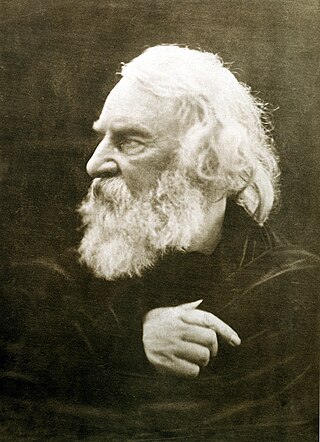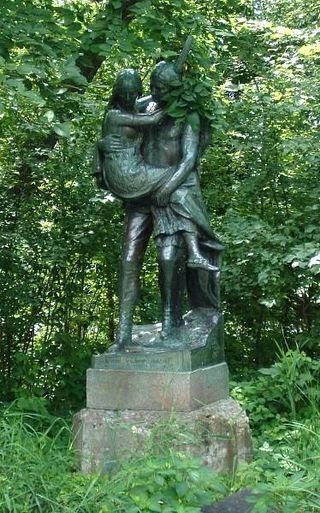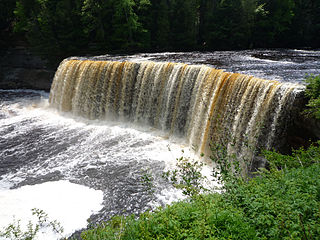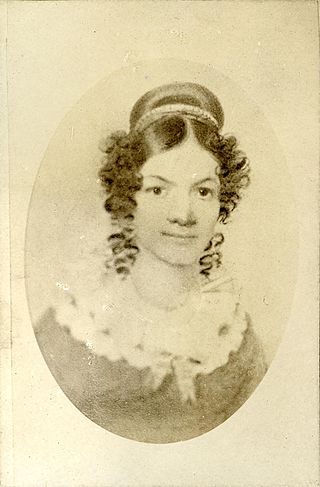Related Research Articles

Henry Wadsworth Longfellow was an American poet and educator. His original works include "Paul Revere's Ride", The Song of Hiawatha, and Evangeline. He was the first American to completely translate Dante Alighieri's Divine Comedy and was one of the fireside poets from New England.

Hiawatha is the largest city and county seat of Brown County, Kansas, United States. As of the 2020 census, the population of the city was 3,280.

Hiawatha, also known as Ayenwatha or Aiionwatha, was a precolonial Native American leader and co-founder of the Iroquois Confederacy. He was a leader of the Onondaga people, the Mohawk people, or both. According to some accounts, he was born an Onondaga but adopted into the Mohawks.

The Ojibwe, Ojibwa, Chippewa, or Saulteaux are an Anishinaabe people in what is currently southern Canada, the northern Midwestern United States, and Northern Plains. They are Indigenous peoples of the Subarctic and Northeastern Woodlands.

The Song of Hiawatha is an 1855 epic poem in trochaic tetrameter by Henry Wadsworth Longfellow which features Native American characters. The epic relates the fictional adventures of an Ojibwe warrior named Hiawatha and the tragedy of his love for Minnehaha, a Dakota woman. Events in the story are set in the Pictured Rocks area of Michigan on the south shore of Lake Superior. Longfellow's poem is based on oral traditions surrounding the figure of Manabozho, but it also contains his own innovations.

Henry Rowe Schoolcraft was an American geographer, geologist, and ethnologist, noted for his early studies of Native American cultures, as well as for his 1832 expedition to the source of the Mississippi River. He is also noted for his major six-volume study of Native Americans commissioned by Congress and published in the 1850s.
Nokomis is the name of Nanabozho's grandmother in the Ojibwe traditional stories and was the name of Hiawatha's grandmother in Henry Wadsworth Longfellow's poem, The Song of Hiawatha, which is a re-telling of the Nanabozho stories. Nokomis is an important character in the poem, mentioned in the familiar lines:

Minnehaha Park is a city park in Minneapolis, Minnesota, United States, and home to Minnehaha Falls and the lower reaches of Minnehaha Creek. Officially named Minnehaha Regional Park, it is part of the Minneapolis Park and Recreation Board system and lies within the Mississippi National River and Recreation Area, a unit of the National Park Service. The park was designed by landscape architect Horace W.S. Cleveland in 1883 as part of the Grand Rounds Scenic Byway system, and was part of the popular steamboat Upper Mississippi River "Fashionable Tour" in the 1800s.

Gitche Manitou means "Great Spirit" in several Algonquian languages. Christian missionaries have translated God as Gitche Manitou in scriptures and prayers in the Algonquian languages.

Lacrosse has its origins in a tribal game played by eastern Woodlands Native Americans and by some Plains Indians tribes in what is now the United States of America and Canada. The game was extensively modified by European settlers to create its current collegiate and professional form. There were hundreds of native men playing a ball game with sticks. The game began with the ball being tossed into the air and the two sides rushing to catch it. Because of the large number of players involved, these games generally tended to involve a huge mob of players swarming the ball and slowly moving across the field. Passing the ball was thought of as a trick, and it was seen as cowardly to dodge an opponent. Years later lacrosse is still a popular sport played all over the world. The indigenous people would wear their normal clothes and use a wooden stick and they would play the game with 100-1000 players on each team and they played on 1-2 kilometer fields.
Hiawatha's Rabbit Hunt is a 1941 Merrie Melodies cartoon directed by Friz Freleng. Mel Blanc voiced all characters. This film was nominated for the Academy Award for Best Short Subject (cartoons). This was the first Bugs Bunny cartoon directed by Friz Freleng. The short makes several direct references to The Song of Hiawatha, an epic poem by Henry Wadsworth Longfellow.

The Tahquamenon River is an 89.1-mile-long (143.4 km) blackwater river in the U.S. state of Michigan that flows in a generally eastward direction through the eastern end of the Upper Peninsula. It drains approximately 820 square miles (2,120 km2) of the Upper Peninsula, including large sections of Luce County and Chippewa County. It begins in the Tahquamenon Lakes in northeast Columbus Township of Luce County and empties into Lake Superior near the village of Paradise. M-123 runs alongside a portion of the river.

David Treuer (Ojibwe) is an American writer, critic and academic. As of 2019, he had published seven books; his work published in 2006 was noted as among the best of the year by several major publications. He published a book of essays in 2006 on Native American fiction that stirred controversy by criticizing major writers of the tradition and concluding, "Native American fiction does not exist."

Little Hiawatha is a 1937 animated cartoon produced by Walt Disney Productions, inspired by the poem The Song of Hiawatha by Henry Wadsworth Longfellow. It does not appear to have historical correlation to legendary Mohawk leader and peacemaker Hiawatha. It is the last Silly Symphonies short to be released by United Artists.
Ozhaguscodaywayquay, also called Susan Johnston, was an Ojibwe woman and was an important figure in the Great Lakes fur trade before the War of 1812, as well as a political figure in Northern Michigan after the war. She married the British fur trader John Johnston, an inland trader of the North West Company. They had prominent roles in the crossroads society of Sault Ste. Marie, Michigan and the territory before 1830, and entertained notable visitors from a variety of disciplines. Their daughter Jane Johnston Schoolcraft has become recognized as the first Native American literary writer in the United States.

Jane Johnston Schoolcraft, also known as Bamewawagezhikaquay is the one of earliest Native American literary writers. She was of Ojibwa and Scots-Irish ancestry. Her Ojibwa name can also be written as O-bah-bahm-wawa-ge-zhe-go-qua, meaning "Woman of the Sound [that the stars make] Rushing Through the Sky." From babaam- 'place to place' or bimi- 'along', wewe- 'makes a repeated sound', giizhig 'sky', and ikwe 'woman'. She lived most of her life in Sault Ste. Marie, Michigan.
A Pukwudgie, also spelled Puk-Wudjie, is a human-like creature of Wampanoag folklore, found in Delaware and Prince Edward Island, sometimes said to be 2-to-3-foot-tall.

Hiawatha and Minnehaha is a sculpture by Jacob Fjelde that has stood in Minnehaha Park in Minneapolis since the early twentieth century. Now a popular fixture of the park, its placement there was originally controversial.

Hiawatha is a 1913 American silent drama film directed by Edgar Lewis and based upon Henry Wadsworth Longfellow's epic poem The Song of Hiawatha (1855). The film stars Jesse Cornplanter of the Seneca people and Soon-goot, a 17-year-old unknown actress. The movie is the first feature film to use a cast of Native Americans.

Hiawatha and Minnehaha are 1868 sculptures by Edmonia Lewis. They are in the collection of the Metropolitan Museum of Art on view in gallery 759.
References
- ↑ Native American Stories of the Sacred: Annotated & Explained. SkyLight Paths Publishing. 2005. p. 24. ISBN 978-1-59473-112-9.
- ↑ Henry Wadsworth Longfellow; Chase Salmon Osborn; Stellanova Osborn (1944). "Hiawatha".: with its original Indian legends, compiled, with essays on its authentic background of lake Superior country and Chippewa Indians. The Jaques Cattell Press. p. 200.
- ↑ American Penny Magazine, and Family Newspaper. T. Dwight. 1845. p. 89.
- 1 2 Stewart Culin (1 January 1992). Games of the North American Indians: Games of chance. U of Nebraska Press. p. 67. ISBN 0-8032-6355-4.
